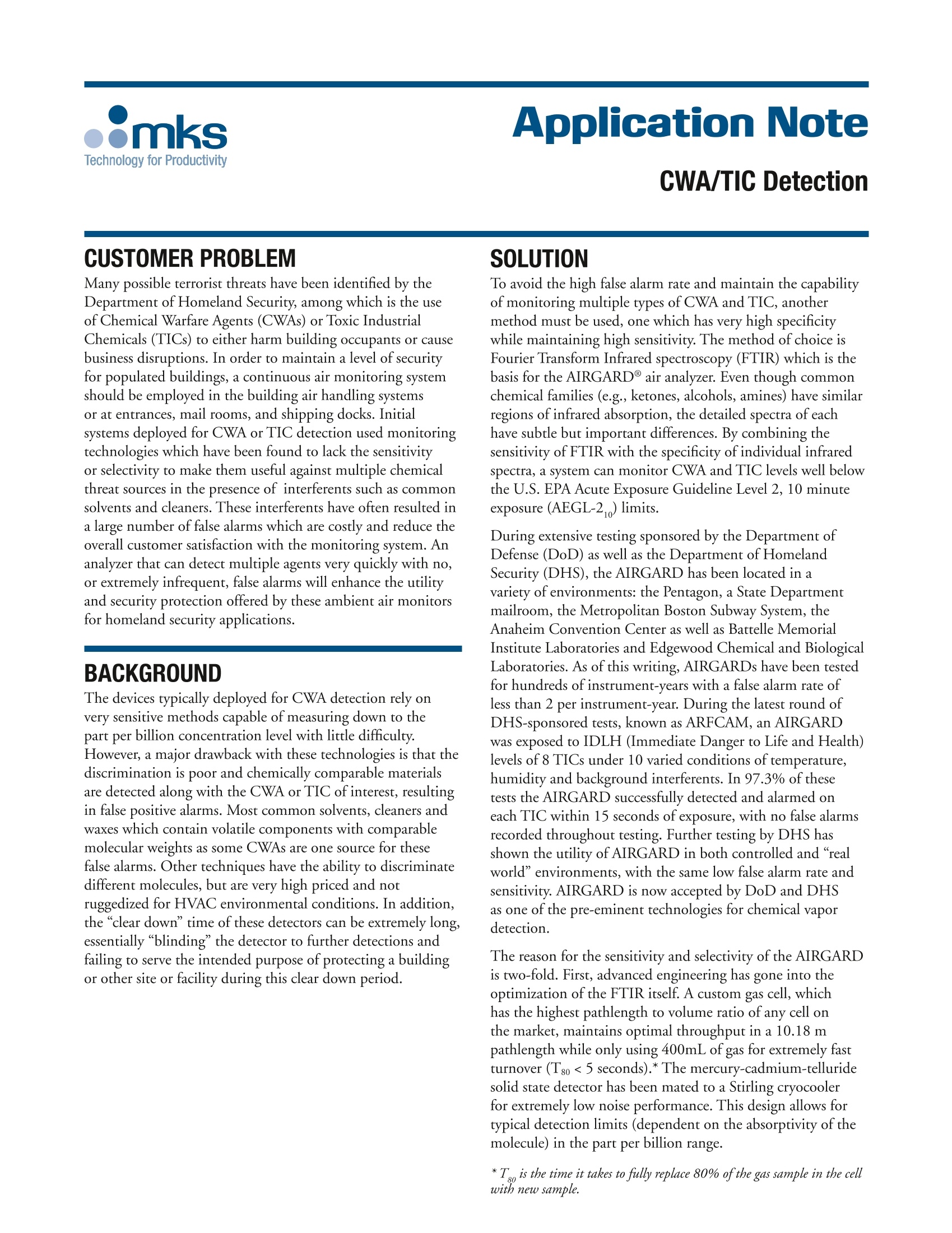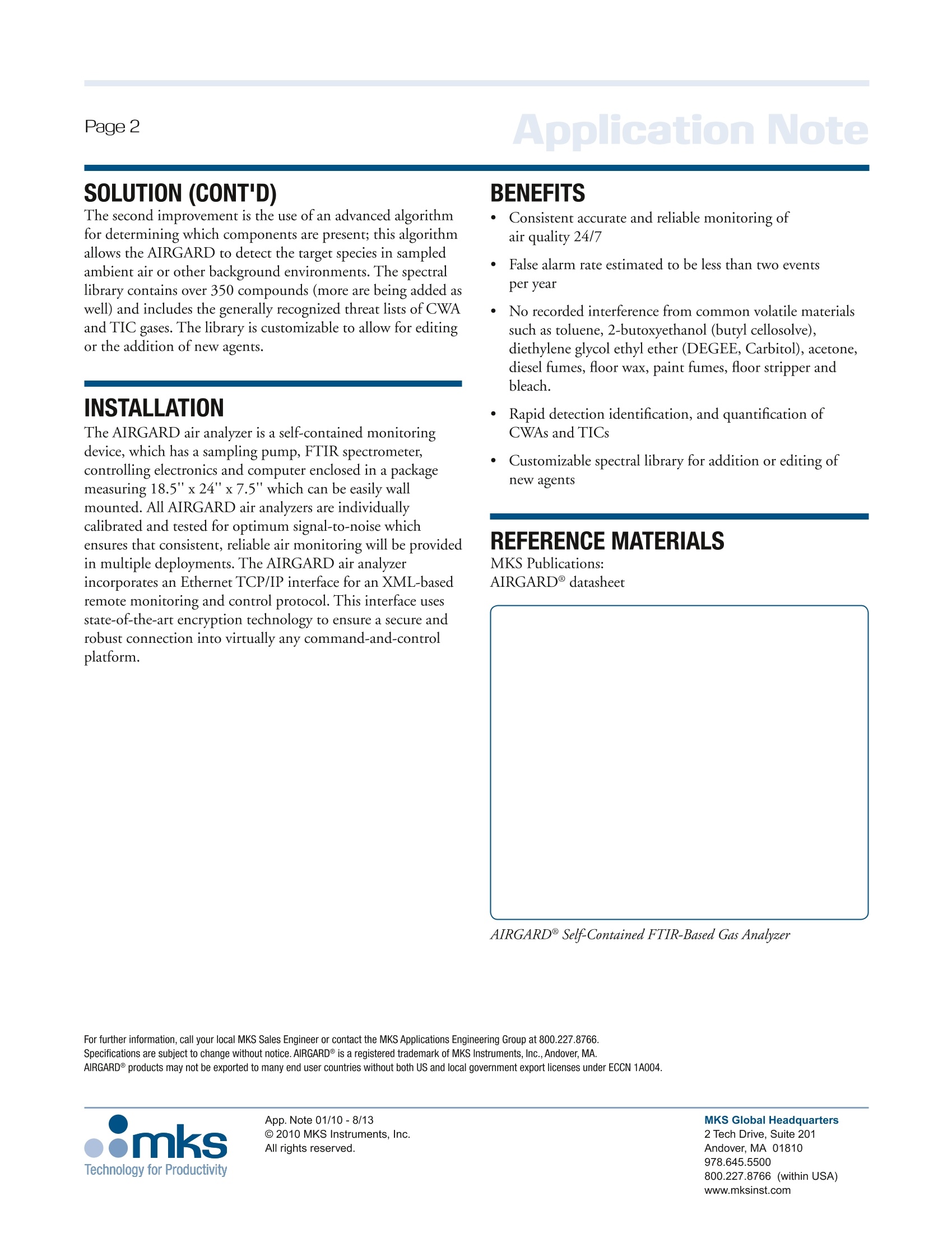
方案详情
文
CUSTOMER PROBLEM:Many possible terrorist threats have been identified by the Department of Homeland Security, among which is the use of Toxic Industrial Chemicals (TICs) to either harm building occupants or cause business disruptions. In order to maintain a level of security for populated buildings, a continuous air monitoring system should be employed in the building air handling systems or at entrances, mail rooms, and shipping docks. Initial systems deployed for TIC detection used monitoring technologies which have been found to lack the sensitivity or selectivity to make them useful against multiple chemical threat sources in the presence of interferents such as common solvents and cleaners. These interferents have often resulted in a large number of false alarms which are costly and reduce the overall customer satisfaction with the monitoring system. An analyzer that can detect multiple agents very quickly with no, or extremely infrequent, false alarms will enhance the utility and security protection offered by these ambient air monitors for homeland security applications.
方案详情

Technology for ProductivityFor further information, call your local MKS Sales Engineer or contact the MKS Applications Engineering Group at 800.227.8766.MKS Global HeadquartersC2010 MKS Instruments, Inc.2 Tech Drive, Suite 201Andover, MA 01810All rights reserved.978.645.5500Technology for Productivity Application NoteCWA/TIC Detection CUSTOMER PROBLEM Many possible terrorist threats have been identified by theDepartment of Homeland Security, among which is the useof Chemical Warfare Agents (CWAs) or Toxic IndustrialChemicals (TICs) to either harm building occupants or causebusiness disruptions. In order to maintain a level of securityfor populated buildings, a continuous air monitoring systemshould be employed in the building air handling systemsor at entrances, mail rooms, and shipping docks. Initialsystems deployed for CWA or TIC detection used monitoringtechnologies which have been found to lack the sensitivityor selectivity to make them useful against multiple chemicalthreat sources in the presence of interferents such as commonsolvents and cleaners. These interferents have often resulted ina large number of false alarms which are costly and reduce theoverall customer satisfaction with the monitoring system. Ananalyzer that can detect multiple agents very quickly with no,or extremely infrequent, false alarms will enhance the utilityand security protection offered by these ambient air monitorsfor homeland security applications. BACKGROUND The devices typically deployed for CWA detection rely onvery sensitive methods capable of measuring down to thepart per billion concentration level with little difficulty.However, a major drawback with these technologies is that thediscrimination is poor and chemically comparable materialsare detected along with the CWA or TIC of interest, resultingin false positive alarms. Most common solvents, cleaners andwaxes which contain volatile components with comparablemolecular weights as some CWAs are one source for thesefalse alarms. Other techniques have the ability to discriminatedifferent molecules, but are very high priced and notruggedized for HVAC environmental conditions. In addition,the “clear down"time of these detectors can be extremely long,essentially “blinding"the detector to further detections andfailing to serve the intended purpose of protecting a buildingor other site or facility during this clear down period. SOLUTION To avoid the high false alarm rate and maintain the capabilityof monitoring multiple types of CWA and TIC, anothermethod must be used, one which has very high specificitywhile maintaining high sensitivity. The method of choice isFourier Transform Infrared spectroscopy (FTIR) which is thebasis for the AIRGARD air analyzer. Even though commonchemical families (e.g., ketones,alcohols, amines) have similarregions of infrared absorption, the detailed spectra of eachhave subtle but important differences. By combining thesensitivity of FTIR with the specificity of individual infraredspectra, a system can monitor CWA and TIC levels well belowthe U.S. EPA Acute Exposure Guideline Level 2, 10 minuteexposure (AEGL-2 ) limits. During extensive testing sponsored by the Department ofDefense (DoD) as well as the Department of HomelandSecurity (DHS), the AIRGARD has been located in avariety of environments: the Pentagon, a State Departmentmailroom, the Metropolitan Boston Subway System, theAnaheim Convention Center as well as Battelle MemorialInstitute Laboratories and Edgewood Chemical and BiologicalLaboratories. As of this writing, AIRGARDs have been testedfor hundreds of instrument-years with a false alarm rate ofless than 2 per instrument-year. During the latest round ofDHS-sponsored tests, known as ARFCAM, an AIRGARDwas exposed to IDLH (Immediate Danger to Life and Health)levels of 8 TICs under 10 varied conditions of temperature,humidity and background interferents. In 97.3% of thesetests the AIRGARD successfully detected and alarmed oneach TIC within 15 seconds of exposure, with no false alarmsrecorded throughout testing. Further testing by DHS hasshown the utility of AIRGARD in both controlled and “realworld"environments, with the same low false alarm rate andsensitivity. AIRGARD is now accepted by DoD and DHSas one of the pre-eminent technologies for chemical vapordetection. The reason for the sensitivity and selectivity of the AIRGARDis two-fold. First, advanced engineering has gone into theoptimization of the FTIR itself. A custom gas cell, whichhas the highest pathlength to volume ratio of any cell onthe market, maintains optimal throughput in a 10.18 mpathlength while only using 400mL of gas for extremely fastturnover (Tso<5 seconds).* The mercury-cadmium-telluridesolid state detector has been mated to a Stirling cryocoolerfor extremely low noise performance. This design allows fortypical detection limits (dependent on the absorptivity of themolecule) in the part per billion range. *Tgo is the time it takes to fully replace 80% of the gas sample in the cellwith new sample. SOLUTION (CONT'D) The second improvement is the use of an advanced algorithmfor determining which components are present; this algorithmallows the AIRGARD to detect the target species in sampledambient air or other background environments. The spectrallibrary contains over 350 compounds (more are being added aswell) and includes the generally recognized threat lists of CWAand TIC gases. The library is customizable to allow for editingor the addition of new agents. INSTALLATION The AIRGARD air analyzer is a self-contained monitoringdevice, which has a sampling pump, FTIR spectrometer,controlling electronics and computer enclosed in a packagemeasuring 18.5" x24"x7.5" which can be easily wallmounted. All AIRGARD air analyzers are individuallycalibrated and tested for optimum signal-to-noise whichensures that consistent, reliable air monitoring will be providedin multiple deployments. The AIRGARD air analyzerincorporates an Ethernet TCP/IP interface for an XML-basedremote monitoring and control protocol. This interface usesstate-of-the-art encryption technology to ensure a secure androbust connection into virtually any command-and-controlplatform. BENEFITS · Consistent accurate and reliable monitoring ofair quality 24/7 False alarm rate estimated to be less than two eventsper year · No recorded interference from common volatile materialssuch as toluene, 2-butoxyethanol (butyl cellosolve),diethylene glycol ethyl ether (DEGEE, Carbitol), acetone,diesel fumes, floor wax, paint fumes, floor stripper andbleach. · Rapid detection identification, and quantification ofCWAs and TICs Customizable spectral library for addition or editing ofnew agents REFERENCE MATERIALS MKS Publications: AIRGARDdatasheet AIRGARD Self-Contained FTIR-Based Gas Analyzer Specifications are subject to change without notice. AIRGARD is a registered trademark of MKS Instruments, Inc., Andover, MA.AIRGARD@ products may not be exported to many end user countries without both US and local government export licenses under ECCN 1A004.
确定


还剩1页未读,是否继续阅读?
万机仪器(上海)有限公司为您提供《空气中分子态无机污染物检测方案 》,该方案主要用于空气中其他检测,参考标准--,《空气中分子态无机污染物检测方案 》用到的仪器有
相关方案
更多








